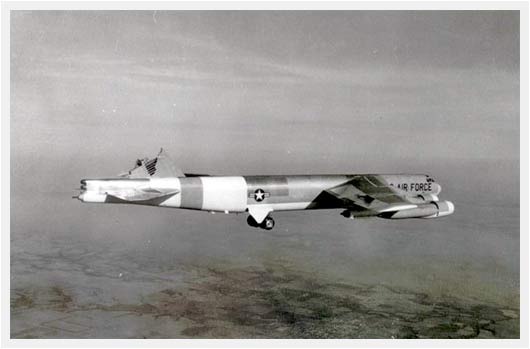Video Proof: B-52 Vertical Fin Is Optional Equipment (1964)
 Wednesday, June 29, 2011 at 10:30PM
Wednesday, June 29, 2011 at 10:30PM  Unbelievable emergency from 1964... and they landed it without any further damage!
Unbelievable emergency from 1964... and they landed it without any further damage!
You may have seen this incredible picture before, but do you know what caused this B-52 to lose almost all of its vertical fin and rudder? Below is the explanation from the Boeing website, and at bottom is video of the occurrence, including the landing approach!
January 10, 1964, started out as a typical day for the flight test group at Boeing's Wichita plant. Pilot Chuck Fisher took off in a B-52H with a three-man Boeing crew, flying a low-level profile to obtain structural data.
Over Colorado, cruising 500 feet above the mountainous terrain, the B-52 encountered some turbulence. Fisher climbed to 14,300 feet looking for smoother air.
At this point the typical day ended.The bomber flew into clear-air turbulence. It felt as if the plane had been placed in a giant high-speed elevator, shoved up and down, and hit by a heavy blow on its right side.
Fisher told the crew to prepare to abandon the plane. He slowed the aircraft and dropped to about 5,000 feet to make it easier to bail out.
But then Fisher regained some control. He climbed slowly to 16,000 feet to put some safety room between the plane and the ground. He informed Wichita about what was happening. Although control was difficult, Fisher said he believed he could get the plane back in one piece.
Response to the situation at Wichita, and elsewhere, was immediate. An emergency control center was set up in the office of Wichita's director of flight test. Key Boeing engineers and other specialists were summoned to provide their expertise. Federal Aviation Administration air traffic control centers at Denver and Kansas City cleared the air around the troubled plane. A Strategic Air Command B-52 in the area maintained radio contact with the crew of the Wichita B-52.
As Fisher got closer to Wichita, a Boeing chase plane flew up to meet him and to visually report the damage. When Dale Felix, flying an F-100 fighter, came alongside Fisher's B-52, he couldn't believe what he saw: The B-52's vertical tail was gone.
Felix broke the news to Fisher and those gathered in the control center. There was no panic. Everyone on the plane and in the control center knew they could be called upon at any time for just such a situation.
In the emergency control center, the engineers began making calculations and suggesting the best way to get the plane down safely.
The Air Force was also lending assistance. A B-52, just taking off for a routine flight, was used to test the various flight configurations suggested by the specialists before Fisher had to try them.
As high gusty winds rolled into Wichita, the decision was made to divert the B-52 to Blytheville Air Force Base in Northeastern Arkansas.
Boeing specialists from the emergency control center took off in a KC-135 and accompanied Fisher to Blytheville, serving as an airborne control center.
Six hours after the incident first occurred, Fisher and his crew brought in the damaged B-52 for a safe landing.
"I'm very proud of this crew and this airplane," Fisher said. "Also we had a lot people helping us, and we're very thankful for that."
The B-52, Fisher said, "Is the finest airplane I ever flew."














































































Reader Comments (1)
Wow hard to believe , but video shows it all